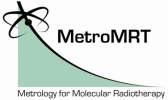The Department of Medical Radiation Physics (MRP), Clinical Sciences, Lund University (LUND) - Sweden

The Department of Medical Radiation Physics (MRP), Clinical Sciences, Lund University, Sweden does both research and research education in the field of Nuclear Medicine, Magnetic Resonance Imaging, Radiotherapy for both clinical and pre-clinical applications. The Department is involved in the Lund Biomedical Imaging Center which includes uSPECT/CT, uPET/CT and uMRI facilities. A new laboratory for labelling new radiopharmaceuticals mainly for therapy applications is built close to two cyclotrons. The department also educates Medical Physicists since the mid 1960s.
The research group at the Department of Medical Radiation Physics participating in this JRP (MP-LUND) has been working for many years in the research and development of methods for Quantitative Imaging with applications in Molecular Radiation Therapy. They have developed the SIMIND Monte Carlo code for simulation of planar, and SPECT scintillation camera imaging and this code has been used by many research groups world-wide. The group also develops methods for dosimetry based on image based activity quantification from 2D (planar) and 3D (SPECT) images, and many of these methods are currently being applied in on-going clinical trials involving 111In-, and 90Y-labelled monoclonal antibodies, and 177Lu labelled peptides. All methods are put together into a package, called LundAdose which is written in the IDL (Interactive Data Language) programming environment. The group recently has been working with 90Y bremsstrahlung imaging and quantification procedures with application in an on-going clinical high-dose 111In/90Y myeloablative escalation study with the liver being the primary organ-at-risk, where accurate dosimetry is performed from both multiple planar and SPECT/CT studies. The study is a true escalation study in terms of absorbed dose and dosimetry is performed both for pre-therapy dose planning purposes and for within-therapy dose verification.
Role and main tasks in the JRP
MRP-LUND will contribute to WP2 and WP4 by their experience in Monte Carlo simulation and will participate in the development of a data base of images that can be used for assessment of the accuracy of absorbed dose estimates.
Suggested steps in the development of such a database are: 1) Benchmarking of the validation methodology by performing parallel experimental imaging (SPECT/CT) and Monte Carlo simulation of images in identical geometries of known activity distributions. Such benchmarking geometries may be generated by creating digitised versions of existing, or new, physical phantoms. 2) For selected radiopharmaceuticals, determine sets of typical kinetic data by merging clinical data from the centres involved in this JRP, and from the literature. MP-LUND can contribute with high-quality kinetic data for 111In/90Y labelled Ibritumomab Tiuxetan (an anti-CD20 monoclonal antibody), and 177Lu-[DOTA0,Tyr3] Octreotate (a peptide). 3) Perform Monte Carlo simulation of scintillation camera images (planar and SPECT) in anthropomorphic computer phantoms, for different time points after injection, to serve as validation images for image based activity quantification schemes. 4) In order to make the images from step 3 useful for a large community, such images should be generated according to the specifications of different camera systems, and should preferably be converted into a file format that can be uploaded into evaluation software in camera systems. 5) If desired, perform absorbed dose calculations of the activity distributions. These can be performed using an in-house developed Monte Carlo code based on EGS4. This would then serve as validation data for absorbed dose calculations. If step 5 is included, then step 1 should preferably be complemented by absorbed dose measurements, for Benchmarking of the absorbed dose calculation program in a geometry which allows both for experimental measurement and Monte Carlo calculation.
For more information: Contact Vere Smyth

